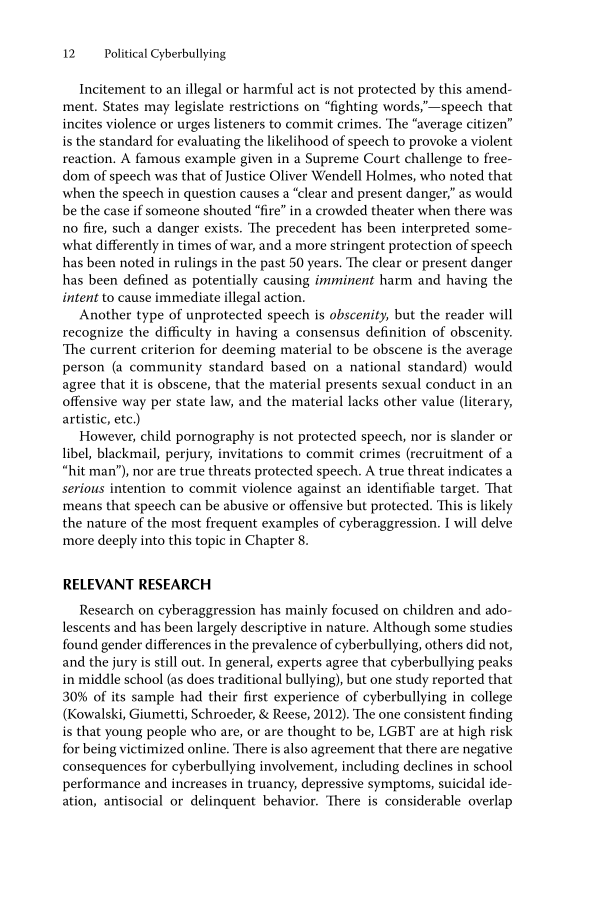12 Political Cyberbullying Incitement to an illegal or harmful act is not protected by this amend- ment. States may legislate restrictions on “fi ghting words,”—speech that incites violence or urges listeners to commit crimes. Th e “average citizen” is the standard for evaluating the likelihood of speech to provoke a violent reaction. A famous example given in a Supreme Court challenge to free- dom of speech was that of Justice Oliver Wendell Holmes, who noted that when the speech in question causes a “clear and present danger,” as would be the case if someone shouted “fi re” in a crowded theater when there was no fi re, such a danger exists. Th e precedent has been interpreted some- what diff erently in times of war, and a more stringent protection of speech has been noted in rulings in the past 50 years. Th e clear or present danger has been defi ned as potentially causing imminent harm and having the intent to cause immediate illegal action. Another type of unprotected speech is obscenity, but the reader will recognize the diffi culty in having a consensus defi nition of obscenity. Th e current criterion for deeming material to be obscene is the average person (a community standard based on a national standard) would agree that it is obscene, that the material presents sexual conduct in an off ensive way per state law, and the material lacks other value (literary, artistic, etc.) However, child pornography is not protected speech, nor is slander or libel, blackmail, perjury, invitations to commit crimes (recruitment of a “hit man”), nor are true threats protected speech. A true threat indicates a serious intention to commit violence against an identifi able target. Th at means that speech can be abusive or off ensive but protected. Th is is likely the nature of the most frequent examples of cyberaggression. I will delve more deeply into this topic in Chapter 8. RELEVANT RESEARCH Research on cyberaggression has mainly focused on children and ado- lescents and has been largely descriptive in nature. Although some studies found gender diff erences in the prevalence of cyberbullying, others did not, and the jury is still out. In general, experts agree that cyberbullying peaks in middle school (as does traditional bullying), but one study reported that 30% of its sample had their fi rst experience of cyberbullying in college (Kowalski, Giumetti, Schroeder, & Reese, 2012). Th e one consistent fi nding is that young people who are, or are thought to be, LGBT are at high risk for being victimized online. Th ere is also agreement that there are negative consequences for cyberbullying involvement, including declines in school performance and increases in truancy, depressive symptoms, suicidal ide- ation, antisocial or delinquent behavior. Th ere is considerable overlap
Document Details My Account Print multiple pages
Print
You have printed 0 times in the last 24 hours.
Your print count will reset on at .
You may print 0 more time(s) before then.
You may print a maximum of 0 pages at a time.




















































































































































































